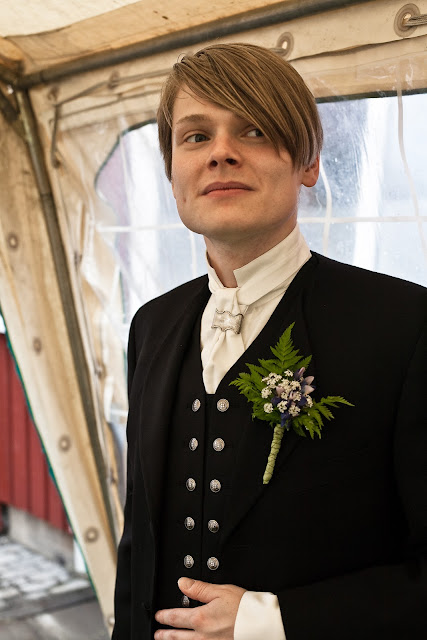Hello all, today I will conclude the series on Icelandic costume by talking a bit about the men's costume, the Þjóðbúningur karla. This is a direct descendant of traditional clothing.
The base is a white cotton or linen shirt with the typical Scandinavian construction, with narrow bands on the shoulders and a band collar.
Traditionally knickers were worn, but today long pants may also be worn. There is a flap in front, and suspenders are used. Ornamented silver buttons are found on the pants, and there may be a lacing in back to accomodate later growth.
If knickers are worn, then knee socks are necessary. These come over the calf, and must be held up by sokkebonde, garters which are either finger-woven or braided. These are simply wrapped around the leg above the calves, and serve to keep the socks up. The socks tend to be plain brown or gray wool, without designs. Here are a couple of guys doing traditional wrestling.
Knickers button at the bottom. Pants and knickers may be black, navy, dark gray, etc.
There is more color in the vests, which are always double-breasted, perhaps as a result of Danish influence.
There are always two rows of buttons in the front, and commonly a silk kerchief is tied around the neck.
A short stocking-cap with tassel is part of the costume as well.
A jacket, treyja, may be worn over the vest, with buttons on the sleeves.
Alternatively, the jacket may be double-breasted, and the vest may be omitted. Jackets with a single row of buttons are also known, and these are called peysa.
Regular shoes may be worn with the costume, or silver buckled shoes, but the most traditional are thin leather moccasin type shoes of either fish or sheep leather, called roðskór and sauðskinssk, respectively. Women often wear these types of shoes as well.
Colorful knitted woolen inserts were worn inside.
Colorful mittens were knitted as well, but not worn in the belt as they are in some other countries.
He also designed an outfit he called Fornmannaklæði which was supposed to represent Viking wear, to be paired with the Kyrtill. This is now also seldom worn, as we now have more accurate information as to what the Vikings actually wore.
There is yet another type of costume which is of more recent derivation. This is called Hátíðarbúningur. It is a formal dress which is based on traditional clothing, as an alternative to the tuxedo. This is quite popular, though some think that it looks too Faeroese or Norwegian.
Thank you for reading, I hope you have found this interesting.
Feel
free to contact me with requests for research. I hope to eventually
cover all of Europe and the Former Russian Empire/Soviet Union. I also
gratefully accept tips on source materials which i may not have. I also
accept commissions to research/design, sew, and/or embroider costumes
or other items for groups or individuals. I also choreograph and teach
folk dance.
Roman K.
email
A good article on the various types of buningur.
http://en.wikipedia.org/wiki/Icelandic_national_costume
Here is the Heimilisiðnaðarsafnið textile museum website
http://textile.is/
The Iceland national costume website. I have relied heavily on this site for information.
http://www.buningurinn.is/?i=2
Other sources:
Hildur Hermóðsdóttir, 'Icelandic National Costumes' Reykjavik, 2012
Elsa Gudjónsson, 'Traditional Icelandic Embroidery', Reykjavik, 1982
Charles Holme, 'Peasant art in Sweden, Lappland and Iceland', London, 1910
Frederik Christian Lund, 'Danske Nationaldragter', 1915
Bunad Magazine nr 4, Dec. 2012
Jamed Snowden, 'The Folk Dress of Europe', 1979































You could be interested as well in the Moldavian Costume...
ReplyDeletehttps://picasaweb.google.com/106145278869141543959/MoldavianFolkCostume
Thank you for that link,
DeleteI have that book but I was unaware that it had already been scanned online.
Thought I would leave my first comment. I do not know what to say except that I have enjoyed reading. Nice blog, I will continue to visit this blog very often.Urban Styles
ReplyDeleteHello.
ReplyDeleteYou might like to look at our FB sinde you have here on the page some of the costumes that I have made and also some from my students.
Best regards
Hildur in Annriki
https://www.facebook.com/pages/Annr%C3%ADki-%C3%9Ej%C3%B3%C3%B0b%C3%BAningar-og-skart/329231827155867
Thank you for sharing this resource. Thank you also for doing such important work
DeleteI am doing some historical re-enactment and would like to make the "fish shoes" (my keyboard doesn't have all the marks but they are spelled Rooskor) The questions I have are: is there a seam across the sole? If the leather I have (yes, I found fish leather) isn't wide enough,how would I make it wider? What was used as the lacing? Was it waxed linen? If so, was it hempen linen, or flaxen linen? Were holes punched to contain the lacing or were they created some other way? Were the shoes worn with the lacing drawn tight? please contact me at beltkathy49@gmail.com
ReplyDeleteThanks For This! ❤️
ReplyDelete❤️❤️
ReplyDeleteA design like yours with a few simple adjustments would really make my blog shine.
ReplyDeleteKeep sharing such good stuff
ReplyDeleteKeep doing this in future. I will support you.
ReplyDeleteThat is a good tip especially to those new to the blogosphere. Brief but very accurate info…
ReplyDeleteGreat Post for Beginner to understand.
ReplyDeleteNice info, I love the way you express words with emotions.
ReplyDelete
ReplyDeleteThankyou for this wonderful article. I regularly read your article, all are very amazing
It looks like you spend a lot of effort and time on your blog.
ReplyDeleteI’m really glad I have found this information.
ReplyDeleteI am really enjoying reading your well written articles.
ReplyDeleteThanks For Sharing Such An Excellent Post Enjoyed Reading it.
ReplyDeleteGreat job for publishing such a beneficial web site.
ReplyDeleteHello, I’m happy to see some great articles on your site.
ReplyDeleteImpressive!Thanks for giving me an idea to my site.
ReplyDeleteExcellent and nice post. It will beneficial for everyone.
ReplyDeleteThanks for posting this educative writeup. I really like your means of blogging.
ReplyDeleteThank you for the good story. Considered a great and very useful content.
ReplyDeleteWow, superb blog layout! Magnificent, let alone the content fantastic.
ReplyDeleteCool
ReplyDelete